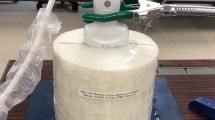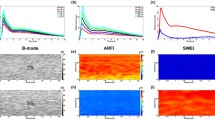Abstract
Purpose
Tissue elasticity can be measured and mapped using color Doppler elastography. In a previous study, a binary pattern of shear waves was observed using a color flow imaging (CFI) system with matched pulse Doppler packet size as well as shear wave frequency and displacement condition. In the present study, we demonstrate the possibility of mapping shear wave velocity and resolving phantom elasticity using any commercial ultrasound machine without fulfilling that condition.
Methods
We derive a relation between Doppler autocorrelator integration time and the estimated flow velocity. The underlying principles behind the shear wave shadows captured by a typical modern ultrasound machine are investigated. The ultrasound machine measurement preset is calibrated to remove the effect of transducer array scanning delay in modifying the appearing wavenumber and thus correct the measurement error.
Results
The method was used to successfully measure the elasticity of a biological tissue-mimicking phantom and distinguish a stiff phantom from a soft phantom.
Conclusion
Using this method, the elasticity of a biological tissue-mimicking phantom can be recovered with less strict constraint. As a result, it provides more flexibility to be implemented in common ultrasound machines. This method may be practically used to help identify tissue stiffness-related disease.







Similar content being viewed by others
References
Parker KJ, Doyley MM, Rubens DJ. Imaging the elastic properties of tissue: the 20 year perspective. Phys Med Biol. 2011;56:R1–29.
Lerner RM, Parker KJ, Holen J, et al. Sono-elasticity: medical elasticity images derived from ultrasound. In: Acoustical imaging. Boston: Springer; 1988. p. 317–27.
Huang SR, Lerner RM, Parker KJ. Time domain Doppler estimators of the amplitude of vibrating targets. J Acoust Soc Am. 1992;91:965–74.
Yamakoshi Y, Sato J, Sato T. Ultrasonic imaging of internal vibration of soft tissue under forced vibration. IEEE Trans Ultrason Ferroelectr Freq Control. 1990;32:45–53.
Wu Z, Taylor LS, Rubens DJ, et al. Sonoelastographic imaging of interference patterns for estimation of the shear velocity of homogeneous biomaterials. Phys Med Biol. 2004;49:911–22.
Hoyt K, Parker KJ, Rubens DJ. Real-time shear velocity imaging using sonoelastographic techniques. Ultrasound Med Biol. 2007;33:1086–97.
Nightingale K, McAleavey S, Trahey G. Shear-wave generation using acoustic radiation force: in vivo and ex vivo results. Ultrasound Med Biol. 2003;29:1715–23.
Yamakoshi Y, Kasahara T, Iijima T. Shear wave wavefront mapping using ultrasound color flow imaging. Ultrason Imaging. 2015;37:323–40.
Wu CH, Chen WS, Wang TG. Musculoskeletal imaging: elasticity of the coracohumeral ligament in patients with adhesive capsulitis of the shoulder. Radiology. 2016;278:458–64.
Kasai C, Namekawa K, Koyano A, Omoto R. Real-time two-dimensional blood flow imaging using an autocorrelation technique. IEEE Trans Sonic Ultrasonic. 1985;SU-32:458–64.
Hermawan N, Fujiwara M, Hagiwara Y, et al. Visualization of shoulder ligaments motion by ultrasound speckle tracking method. Ann Int Conf IEEE Eng Med Biol Soc. 2020;42:2084–7.
Acknowledgements
This work was supported by the DSP II Program of the Graduate School of Information Science, Tohoku University, based on MEXT Scholarship. This work was also supported in part by study assignment (No: 44953/A2.1/KP/2018) from Institut Teknologi Sepuluh Nopember (ITS). The authors express deep gratitude to Prof. Yoshiki Yamakoshi (Gunma University) for providing the basic knowledge on shear wave elastography; as well as to Aoi Sato and Mizuki Fujiwara for helping with the measurements.
Author information
Authors and Affiliations
Corresponding author
Ethics declarations
Conflict of interest
Norma Hermawan, Takuro Ishii, and Yoshifumi Saijo declare that they have no conflicts of interest.
Ethical statement
All the procedures followed were in accordance with ethical standards in institutional and national guidelines.
Additional information
Publisher's Note
Springer Nature remains neutral with regard to jurisdictional claims in published maps and institutional affiliations.
Appendix
Appendix
Suppose a color Doppler imaging system is used to estimate the flow velocity of a propagating sine wave in a medium with packet size N = 4. For \(-\uppi /2<\Delta {\phi }_{i}<\uppi /2\), the estimated velocity is calculated by
By trigonometric decomposition, we would come up with
where
\(A={\phi }_{0}+{\frac{4\pi {f}_{0}}{c}\xi }_{m}\mathrm{sin}\left({\omega }_{\mathrm{b}}t+{\phi }_{\mathrm{b}}\right)\mathrm{cos}\left({\omega }_{\mathrm{b}}\frac{{T}_{\mathrm{a}}}{2}\right)\), \(B=\frac{4\pi {f}_{0}}{c}{\xi }_{m}\mathrm{cos}\left({\omega }_{\mathrm{b}}t+{\phi }_{\mathrm{b}}\right)\mathrm{sin}\left({\omega }_{\mathrm{b}}\frac{{T}_{\mathrm{a}}}{2}\right)\), \(C={\phi }_{0}+{\frac{4\pi {f}_{0}}{c}\xi }_{m}\mathrm{sin}\left({\omega }_{\mathrm{b}}t+{\phi }_{\mathrm{b}}\right)\mathrm{cos}\left({\omega }_{\mathrm{b}}\frac{{T}_{\mathrm{a}}}{4}\right)\), \(D=\frac{4\pi {f}_{0}}{c}{\xi }_{m}\mathrm{cos}\left({\omega }_{\mathrm{b}}t+{\phi }_{\mathrm{b}}\right)\mathrm{sin}\left({\omega }_{\mathrm{b}}\frac{{T}_{\mathrm{a}}}{4}\right)\) and \(Z={\phi }_{0}+\frac{4\pi {f}_{0}}{c}{\xi }_{m}\mathrm{sin}\left({\omega }_{\mathrm{b}}t+{\phi }_{\mathrm{b}}\right)\).
If the shear wave frequency is much smaller than PRF, we may approximate
Under this condition, we approximate velocity by
On the other hand,
Therefore
In this approximation, a similar result is obtained by
If we reduce the packet size to N = 2 by removing the second and fourth pulses from the calculation, the velocity estimation is
If we reduce further to a single packet size, leaving only the first and last pulses in the calculation, the velocity estimation becomes
This derivation suggests that omitting ultrasound pulses other than the first and last signals does not significantly affect the estimation of sinusoid flow velocity.
About this article
Cite this article
Hermawan, N., Ishii, T. & Saijo, Y. Color Doppler shear wave elastography using commercial ultrasound machine with compensated transducer scanning delay. J Med Ultrasonics 49, 163–173 (2022). https://doi.org/10.1007/s10396-022-01194-7
Received:
Accepted:
Published:
Issue Date:
DOI: https://doi.org/10.1007/s10396-022-01194-7




